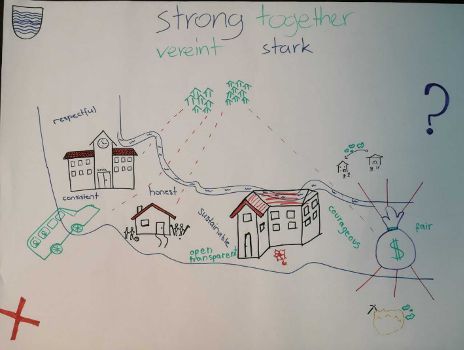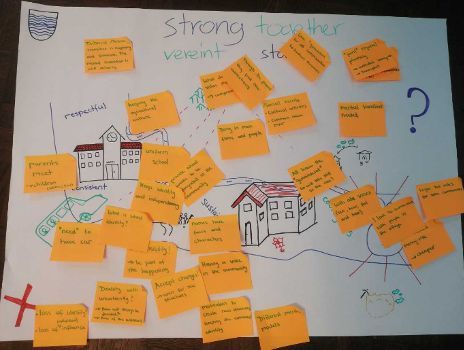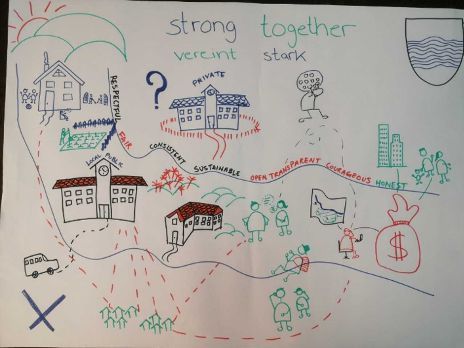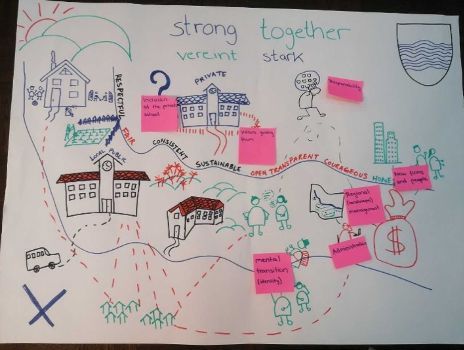Rich picture - 'strong together/vereint stark'
The rich picture - element of the soft systems methodology - was applied in order to grasp different perspectives on a municipality amalgamation process.
Context
This experience report highlights one activity, namely the rich picture, of the Winter School 2020 “Science Meets Practice” (WS) organized by the Transdisciplinarity Lab at ETH Zurich. Though the Winter School curriculum was framed by the design thinking approach and we, as the participants, were able to adapt methods from other approaches, including soft systems methodology, the source of this method.
Purpose
The goal of implementing this “rich picture” method in the context of the WS 2020 was to capture the diversity of perspectives that stakeholders have within a community. The topic we were concerned with was a community amalgamation process in which residents had to come to a common understanding of what it means for many villages to come together as one administrative body in a relatively short period of time. Due to the contentious and emotional nature of the issue, it was important to help participants of the WS 2020, who were external to these community dynamics, to capture the different perspectives that exist within the community and to be able to integrate those perspectives into a cohesive understanding of the system and important points of tension. The “rich picture” method was used to help participants create this understanding iteratively through modifying a visual representation of the problem situation over a period of four days.
Procedure employed
We interacted with the residents from Wislikofen and the surrounding communities in a series of formal and informal events over a course of two weeks in order to understand the challenges they are currently facing. After each interaction, our task was to draw or edit the rich picture on the amalgamation of the communities respectively. In Table 1, our drafting process of the rich picture is shown. Each interaction in the informal and formal environments allowed us to iteratively get a ‘richer’ picture of the things happening in the region.
- Interaction 1: Presentation by the mayor of the community, lunch with council members and community walkthrough with a historian
- Interaction 2: Coffee & Cake Session with the residents
- Interaction 3: Informal lunch with the residents
The rich pictures served us to formulate problem statements that captured the main issues we identified. The problem statements where then fed into an ongoing design thinking process (see step 2 in the method profile).





Findings
Many conversations brought up the subject of “identity”. People were proud of their local identity and were afraid of losing it. Through the discussions, we tried to find out what is exactly behind the word “identity”. In our understanding, it is less about the history or long residence but rather about personal connections and interactions in their communities. People like to know their neighbors and representatives. This allows them to stay informed about what is happening in their community and to intervene early on if they disagree with the direction in which things are moving. The fact that the new amalgamation municipality Zurzach is much bigger and not everyone will know the council members personally anymore is a big step for many residents. From the discussions around the rich picture, we developed the idea of exploring ways in which people interact with the community leaders and finding out what enables residents to participate in the decision-making process and how they can feel part of said process.
Lessons learnt
- Especially the stories of the residents helped us to understand their main concerns regarding the future amalgamation process.
- The rich picture helped us to have an overview of all the elements that have already influenced and still influence the amalgamation process. By drawing all the elements, we were also able to identify missing pieces of the system, which flowed into our next discussions with the residents.
- Some residents also had a look at the rich pictures and immediately started highlighting which elements are missing in their perspective. A rich picture thus may help to start profound discussion with stakeholders.
- A challenge for us was to draw our insights in a way that they are clear at first glance also for other persons. Sometimes we would have preferred to add post-its with verbal explanations.

